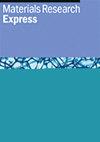Investigating mechanical properties of 3D printed porous titanium scaffolds for bone tissue engineering
IF 2.2
4区 材料科学
Q3 MATERIALS SCIENCE, MULTIDISCIPLINARY
引用次数: 0
Abstract
Objective. Three-dimensional (3D) printed porous titanium scaffolds serve as a bone tissue engineering technology that offers a promising solution for addressing bone defects. The scaffold’s pore structure offers structural support and facilitates the proliferation of bone cells. Therefore, investigating the aperture and pore shape is of crucial for the development of 3D printed porous titanium scaffolds. Methods. Ti6Al4V scaffolds with the specified structure were fabricated using selective laser melting (SLM) technology. The scaffolds comprised fifteen cylindrical models measuring 20 mm in diameter and 20 mm in height. These models featured five scaffold shapes: imitation diamond-60°, imitation diamond-90°, imitation diamond-120°, regular tetrahedron and regular hexahedron. Each of these structural shapes was characterized by three different aperture sizes (400 μm, 600 μm and 800 μm). The porosity and mechanical properties of Ti6Al4V scaffolds were examined. Results. The measured porosity of Ti6Al4V scaffolds varied between 56.50% and 95.28%. The porosity increased with the size of the aperture. The mechanical properties tests revealed that, for identical apertures, the compressive strength and torsional strength were influenced by the configuration of the unit structure. Furthermore, the positive and lateral compressive strength as well as torsional strength of various unit structures exhibited distinct advantages and disadvantages. Within a uniform unit structure shape, the compressive strength and torsional strength were found to be correlated with the size of apertures, indicating that larger apertures result in decreased compressive and torsional strength. Conclusion. The configuration of the aperture and the shape of the pore were identified as significant factors that influenced the compressive strength. The compressive strength of Ti6Al4V scaffolds with various unit structure shapes exhibited both advantages and disadvantages when subjected to positive, lateral, and torsional forces. The enlarged aperture augmented the scaffold’s porosity while diminishing its compressive and torsional strength.研究用于骨组织工程的 3D 打印多孔钛支架的机械特性
目的。三维(3D)打印多孔钛支架是一种骨组织工程技术,为解决骨缺损问题提供了一种前景广阔的解决方案。支架的孔隙结构可提供结构支撑并促进骨细胞增殖。因此,研究孔径和孔形状对于开发三维打印多孔钛支架至关重要。研究方法采用选择性激光熔融(SLM)技术制造了具有特定结构的 Ti6Al4V 支架。支架由 15 个直径 20 毫米、高 20 毫米的圆柱形模型组成。这些模型具有五种支架形状:仿钻石-60°、仿钻石-90°、仿钻石-120°、正四面体和正六面体。每种结构形状都有三种不同的孔径大小(400 微米、600 微米和 800 微米)。对 Ti6Al4V 支架的孔隙率和机械性能进行了检测。结果。测得的 Ti6Al4V 支架孔隙率介于 56.50% 和 95.28% 之间。孔隙率随着孔径的增大而增加。力学性能测试表明,在孔径相同的情况下,抗压强度和抗扭强度受单元结构配置的影响。此外,不同单元结构的正向和侧向抗压强度以及抗扭强度也各有优缺点。在统一的单元结构形状中,抗压强度和抗扭强度与孔径大小相关,表明孔径越大,抗压强度和抗扭强度越低。结论孔的构造和孔的形状是影响抗压强度的重要因素。具有不同单元结构形状的 Ti6Al4V 支架在承受正向力、侧向力和扭转力时的抗压强度各有利弊。增大的孔径增加了支架的孔隙率,同时降低了其抗压和抗扭强度。
本文章由计算机程序翻译,如有差异,请以英文原文为准。
求助全文
约1分钟内获得全文
求助全文
来源期刊

Materials Research Express
MATERIALS SCIENCE, MULTIDISCIPLINARY-
CiteScore
4.50
自引率
4.30%
发文量
640
审稿时长
12 weeks
期刊介绍:
A broad, rapid peer-review journal publishing new experimental and theoretical research on the design, fabrication, properties and applications of all classes of materials.
 求助内容:
求助内容: 应助结果提醒方式:
应助结果提醒方式:


